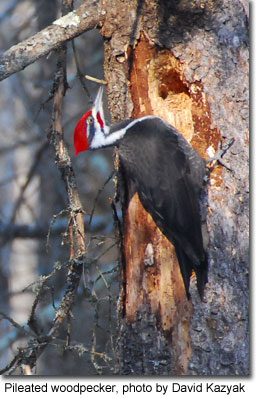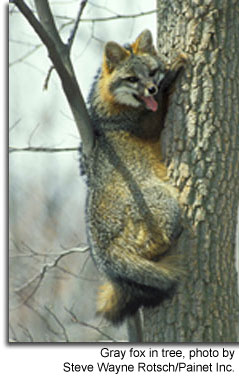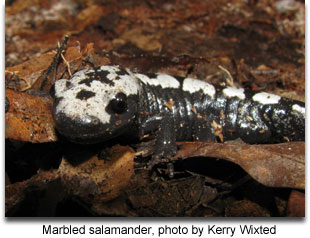
Living trees provide wildlife with food and shelter, but what about dead or dying trees? What possible use could they have in your backyard?
Trees are like any living thing. They have infancy, youth, maturity, old age and death. As the tree ages and eventually dies, changes in the bark and wood create habitat for animals suited to each stage in the life and death of the tree. Dead trees are called "snags" and when snags fall to the ground, they are called logs.
Snags
Animals find shelter in snags. Cavities, which have formed in the heart of a tree from disease or from the loss of limbs, provide a place to nest for woodpeckers, nuthatches, chickadees, bluebirds, owls, wrens, tree swallows, and many other birds as well as raccoons and squirrels. Snakes use tree cavities to shed their skin. Inside a tree, the snake is well hidden during this very vulnerable time. Woodpeckers can actively excavate a nesting cavity in the softwood of a dead tree. When they move out of their hole, other animals can enlarge the entrance and move in. Bats may also roost in tree cavities. Some bat species prefer to roost under the loose bark of a dead tree. The brown creeper, a small forest bird, will nest under loose bark. Ospreys, some hawks, and the great horned owl will nest on top of very tall snags. Cavities and loose bark can also serve a safe place for butterflies and moths to hibernate or metamorphose.
 Snags are also very attractive to insects, which help decompose the various parts of a tree. These insects are food for birds, reptiles and mammals. Animals also eat the fungus which grows on trees. Besides using snags to find food, some animals use cavities and loose bark to store food. With their bare branches, snags are great perches for hawks, eagles, vultures and other carnivorous birds. Mockingbirds will also use a branch as a singing stage.
Snags are also very attractive to insects, which help decompose the various parts of a tree. These insects are food for birds, reptiles and mammals. Animals also eat the fungus which grows on trees. Besides using snags to find food, some animals use cavities and loose bark to store food. With their bare branches, snags are great perches for hawks, eagles, vultures and other carnivorous birds. Mockingbirds will also use a branch as a singing stage.
Logs
When a snag falls and becomes a log, a whole new ecosystem is created. Tiny organisms, bacteria and fungi begin to decompose the log and become food for other organisms and insects, which in turn become food for all kinds of animals. For example, pileated woodpeckers have evolved a beak to extract insects and other food from snags and logs.
Holes left in the wood collect water that becomes a place to drink or bathe. The rotting wood, damp from chemical changes, also attracts salamanders and tree frogs. Logs that have fallen in rivers and ponds provide resting places for birds and turtles, and safe havens for fish. Logs also create a nutrient rich soil in which ferns, forest plants, and trees can grow.
Tips for Snags and Logs

- If you don't have snags or logs on your property, you can include small logs into your landscape. Logs are especially useful if they are shaded most of the time and positioned so soil can becomes entrapped against the log.
- Snags and logs can be improved by encouraging vines to grow on them. Virginia creeper, greenbriar and trumpet vine can be used as food and shelter for animals.
- If you have a pond, a log partially submerged will help make the water more accessible to small animals and can serve as a resting area for turtles, frogs and birds.
- Small clumps of snags scattered over the landscape are generally best. They will provide both nesting and foraging sites. This will also help reduce competition among the species.
- It is possible to create a fallen tree or log by cutting a living tree about ¾ through the trunk and pushing it over. Called a “hinge tree”, this can provide food and shelter for ground dwelling animals, like bobwhite quail.
- It is also possible to create a snag by “girdling” the tree. Girdling involves cutting a band between one and six inches wide through the bark and completely around the tree. This prevents water and nutrients from moving up the bark from the ground to the leaves and eventually kills the tree.

Some Areas of Caution
- Since snags and logs create an important habitat, cleaning up the forest floor actually removes a whole layer of habitat which in turn causes local extinction of all the animals which depend on it.
- If a snag is likely to fall and hit your or your neighbor's house or anything valuable, remove it. You can save and use the removed snag as logs in your landscape.
- Beware of termites, which can be brought into your house from decaying logs in your yard. Keep decaying logs far from the house.
- Check with your community association or local government about the legalities of having decaying logs in your backyard.
Snag Users | Downed Log Users |
| Barred Owl | Black Bear |
| Red-Bellied Woodpecker | Otter |
| Carolina Chickadee | BobWhite |
| Red-Tailed Hawk | Painted Turtle |
| Northern Flicker | Bobcat |
| Screech Owl | River Cooter |
| Eastern Bluebird | Box Turtle |
| Tufted Titmouse | Ruffed Grouse |
| Great Crested Flycatcher | Bullfrog |
| Turkey Vulture | Salamanders |
| Nuthatches | Shrews |
| Wood Duck | Chipmunk |
| Pileated Woodpecker | Skinks |
| Wrens | Eastern Fence Lizard |
| Prothonotary Warbler | Snakes |
| | Fox |
| | Various Bugs and Insects |
| | Mole |
| | Voles |
| | Mouse |
For more information, please contact:
Maryland Department of Natural Resources
Wildlife and Heritage Service
Tawes State Office Building, E-1
Annapolis MD 21401
410-260-8540
Toll-free in Maryland: 1-877-620-8DNR
[email protected]
Acknowledgements:
- Pileated woodpecker, photo by David Kazyak
- Gray fox, photo by Steve Wayne Rotsch/Painet Inc.
- Bobwhite, photo by John White.
- Marbled salamander, photo by Kerry Wixted